
Sylvester J. Pussycat Sr. is a fictional character, an anthropomorphic cat in the Looney Tunes and Merrie Melodies series of cartoons. Most of his appearances have him often chasing Tweety Bird, Speedy Gonzales, or Hippety Hopper. He appeared in 103 cartoons in the golden age of American animation, lagging only behind superstars Bugs Bunny, Porky Pig, and Daffy Duck. Three of his cartoons won Academy Awards, the most for any starring a Looney Tunes character: they are Tweetie Pie, Speedy Gonzales, and Birds Anonymous.

The Reduviidae is a large cosmopolitan family of the suborder Heteroptera of the order Hemiptera. Among the Hemiptera and together with the Nabidae almost all species are terrestrial ambush predators; most other predatory Hemiptera are aquatic. The main examples of non-predatory Reduviidae are some blood-sucking ectoparasites in the subfamily Triatominae, with a few species from South America noted for their ability to transmit Chagas disease. Though spectacular exceptions are known, most members of the family are fairly easily recognizable; they have a relatively narrow neck, sturdy build, and formidable curved proboscis. Large specimens should be handled with caution, if at all, because they sometimes defend themselves with a very painful stab from the proboscis.

Acanthosomatidae is a family of Hemiptera, commonly named "shield bugs" or "stink bugs". Kumar in his 1974 world revision recognized 47 genera; now this number is 55 genera, with about 200 species, and it is one of the least diverse families within Pentatomoidea. The Acanthosomatidae species are found throughout the world, being most abundant in high-latitude temperate regions and in subtropical regions at high altitudes.
Nicrophorus carolina is a burying beetle described by Carl Linnaeus in 1771. Its specific name has commonly been misspelled as carolinus.
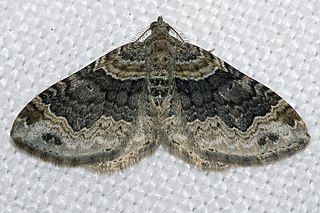
Xanthorhoe ferrugata, the dark-barred twin-spot carpet, is a moth of the genus Xanthorhoe in the family Geometridae. It was first described by Carl Alexander Clerck in 1759 and has a Holarctic distribution.

Centropyge ferrugata, the rusty angelfish, is a species of marine ray-finned fish, a marine angelfish belonging to the family Pomacanthidae. The rusty angelfish comes from the Western Pacific Ocean and sometimes makes its way into the aquarium trade.

Doryodes bistrialis, the double-lined doryodes moth, is a moth of the family Erebidae. The species was first described by Carl Geyer in 1832. It is found in the eastern United States, including Delaware, Virginia, Mississippi and Florida. Its habitat consists of wet pine flatwoods and pine savannas.
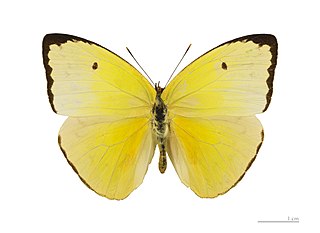
Aphrissa statira, the statira sulphur, is a species of Lepidoptera in the family Pieridae. The species is a medium-sized yellow butterfly, with females more pale than males. They are found from southern regions of Florida and Texas through southern Brazil and northern Argentina. The caterpillars feed on the leaves of several local host plants, while adults prefer to feed on the nectar of red or orange colored flowers. The species is most noted for their dramatic migrations in the tropical areas of the Americas. They have been the subject of many studies about how butterflies navigate and orient during migration.

Bagisara repanda, the wavy lined mallow moth, is a moth of the family Noctuidae. The species was first described by Johan Christian Fabricius in 1793. It is found from the southern United States, south through Guatemala, Panama, the Antilles, Paraguay, Colombia, Venezuela, Guyana and Brazil to Argentina.

Lantanophaga pusillidactyla, the lantana plume moth, is a moth of the family Pterophoridae. It is native to the southern United States, Mexico, the Caribbean, and South America.
Notioplusia illustrata, the notioplusia moth, is a moth of the family Noctuidae first described by Achille Guenée in 1852. It is native to Saint Kitts, the Greater Antilles, Florida, Mexico, Panama and South America. It was introduced to Australia and South Africa.
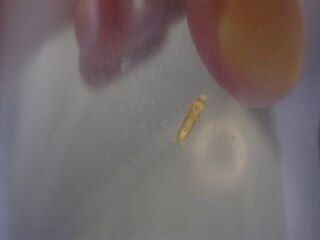
Erechthias minuscula, the erechthias clothes moth, is a moth of the family Tineidae. It was first described by Lord Walsingham in 1897. It is widespread and has been recorded from Africa, Sri Lanka, Java, Australia, the Caroline Islands, Fiji, Samoa, the Marquesas, the West Indies, Hawaii and Florida.

Phrygionis paradoxata, the jeweled satyr moth or silvery phrygionis, is a moth of the family Geometridae. The species was first described by Achille Guenée in 1858. It is found in South America, Central America, Florida, and the Caribbean.
BugGuide is a website and online community of naturalists, both amateur and professional, who share observations of arthropods such as insects, spiders, and other related creatures. The website consists of informational guide pages and many thousands of photographs of arthropods from the United States and Canada which are used for identification and research. The non-commercial site is hosted by the Iowa State University Department of Entomology. BugGuide was conceived by photographer Troy Bartlett in 2003 and since 2006 has been maintained by John VanDyk, an adjunct assistant professor of entomology and a senior systems analyst at Iowa State University. The website has been recognized for helping change the public perception of insects.
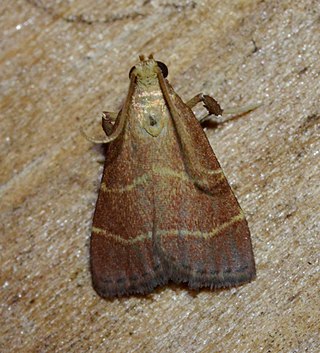
Arta statalis, the posturing arta moth, is a species of snout moth in the genus Arta. It was described by Augustus Radcliffe Grote in 1875 and is the type species of its genus.

Diatraea crambidoides, the southern cornstalk borer moth, is a species of moth of the family Crambidae described by Augustus Radcliffe Grote in 1880. It is found in North America, from Alabama and northern Florida to Ohio and Maryland. Its wingspan is 15–40 mm.
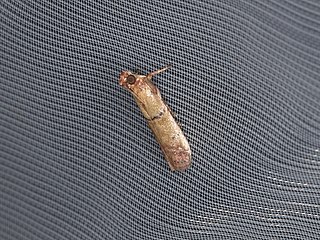
Atheloca subrufella, the palm bud moth or coconut moth, is a species of snout moth described by George Duryea Hulst in 1887. It is found in the US states of Georgia and Florida, and in northern Mexico, Cuba, the Virgin Islands and Brazil.
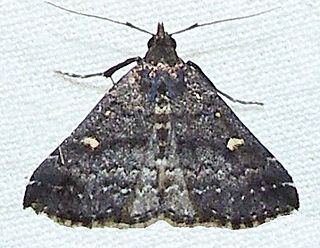
Hypenula cacuminalis, the long-horned owlet moth, is a moth of the family Erebidae. The species was first described by Francis Walker in 1859. It is found from the south-eastern United States west to Texas and Arizona.

Leptopterna ferrugata is a species of plant bug in the family Miridae. It is found in Europe to the east to Siberia and in the south to the northern Mediterranean basin and to Asia Minor. It is an adventive species in North America.
















